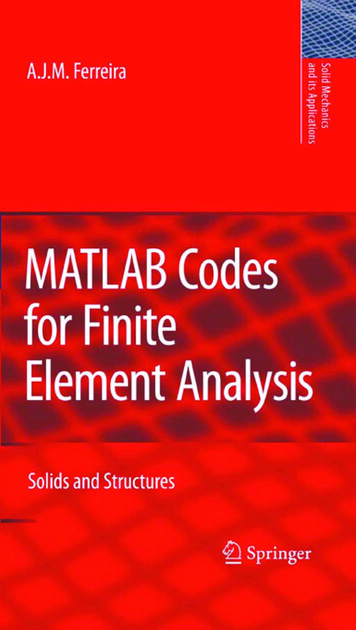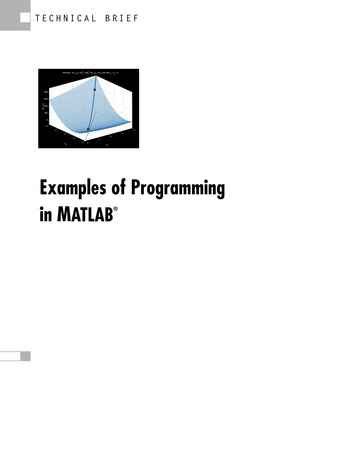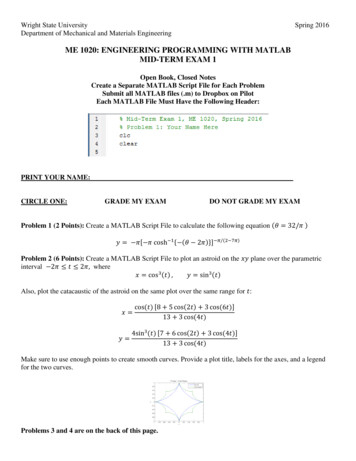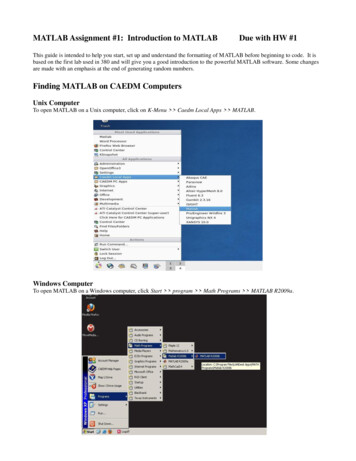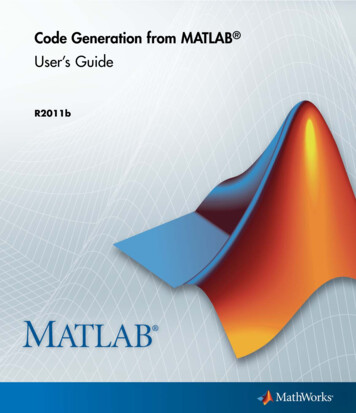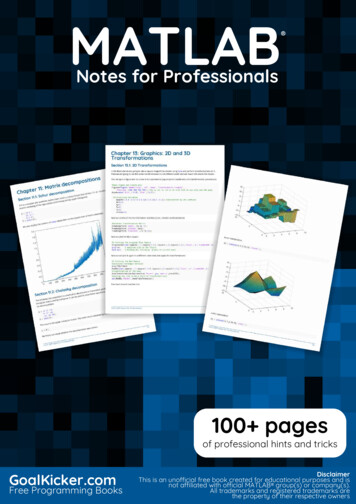
Transcription
MATLABMATLABNotes for Professionals Notes for Professionals100 pagesof professional hints and tricksGoalKicker.comFree Programming BooksDisclaimerThis is an uno cial free book created for educational purposes and isnot a liated with o cial MATLAB group(s) or company(s).All trademarks and registered trademarks arethe property of their respective owners
ContentsAbout . 1Chapter 1: Getting started with MATLAB Language . 2Section 1.1: Indexing matrices and arrays . 3Section 1.2: Anonymous functions and function handles . 8Section 1.3: Matrices and Arrays . 11Section 1.4: Cell arrays . 13Section 1.5: Hello World . 14Section 1.6: Scripts and Functions . 14Section 1.7: Helping yourself . 16Section 1.8: Data Types . 16Section 1.9: Reading Input & Writing Output . 19Chapter 2: Initializing Matrices or arrays . 21Section 2.1: Creating a matrix of 0s . 21Section 2.2: Creating a matrix of 1s . 21Section 2.3: Creating an identity matrix . 21Chapter 3: Conditions . 22Section 3.1: IF condition . 22Section 3.2: IF-ELSE condition . 22Section 3.3: IF-ELSEIF condition . 23Section 3.4: Nested conditions . 24Chapter 4: Functions . 27Section 4.1: nargin, nargout . 27Chapter 5: Set operations . 29Section 5.1: Elementary set operations . 29Chapter 6: Documenting functions . 30Section 6.1: Obtaining a function signature . 30Section 6.2: Simple Function Documentation . 30Section 6.3: Local Function Documentation . 30Section 6.4: Documenting a Function with an Example Script . 31Chapter 7: Using functions with logical output . 34Section 7.1: All and Any with empty arrays . 34Chapter 8: For loops . 35Section 8.1: Iterate over columns of matrix . 35Section 8.2: Notice: Weird same counter nested loops . 35Section 8.3: Iterate over elements of vector . 36Section 8.4: Nested Loops . 37Section 8.5: Loop 1 to n . 38Section 8.6: Loop over indexes . 39Chapter 9: Object-Oriented Programming . 40Section 9.1: Value vs Handle classes . 40Section 9.2: Constructors . 40Section 9.3: Defining a class . 42Section 9.4: Inheriting from classes and abstract classes . 43Chapter 10: Vectorization . 47Section 10.1: Use of bsxfun . 47Section 10.2: Implicit array expansion (broadcasting) [R2016b] . 48
Section 10.3: Element-wise operations . 49Section 10.4: Logical Masking . 50Section 10.5: Sum, mean, prod & co . 51Section 10.6: Get the value of a function of two or more arguments . 52Chapter 11: Matrix decompositions . 53Section 11.1: Schur decomposition . 53Section 11.2: Cholesky decomposition . 53Section 11.3: QR decomposition . 54Section 11.4: LU decomposition . 54Section 11.5: Singular value decomposition . 55Chapter 12: Graphics: 2D Line Plots . 56Section 12.1: Split line with NaNs . 56Section 12.2: Multiple lines in a single plot . 56Section 12.3: Custom colour and line style orders . 57Chapter 13: Graphics: 2D and 3D Transformations . 61Section 13.1: 2D Transformations . 61Chapter 14: Controlling Subplot coloring in MATLAB . 64Section 14.1: How it's done . 64Chapter 15: Image processing . 65Section 15.1: Basic image I/O . 65Section 15.2: Retrieve Images from the Internet . 65Section 15.3: Filtering Using a 2D FFT . 65Section 15.4: Image Filtering . 66Section 15.5: Measuring Properties of Connected Regions . 67Chapter 16: Drawing . 70Section 16.1: Circles . 70Section 16.2: Arrows . 71Section 16.3: Ellipse . 74Section 16.4: Pseudo 4D plot . 75Section 16.5: Fast drawing . 79Section 16.6: Polygon(s) . 80Chapter 17: Financial Applications . 82Section 17.1: Random Walk . 82Section 17.2: Univariate Geometric Brownian Motion . 82Chapter 18: Fourier Transforms and Inverse Fourier Transforms . 84Section 18.1: Implement a simple Fourier Transform in MATLAB . 84Section 18.2: Images and multidimensional FTs . 85Section 18.3: Inverse Fourier Transforms . 90Chapter 19: Ordinary Di erential Equations (ODE) Solvers . 92Section 19.1: Example for odeset . 92Chapter 20: Interpolation with MATLAB . 94Section 20.1: Piecewise interpolation 2 dimensional . 94Section 20.2: Piecewise interpolation 1 dimensional . 96Section 20.3: Polynomial interpolation . 101Chapter 21: Integration . 105Section 21.1: Integral, integral2, integral3 . 105Chapter 22: Reading large files . 107Section 22.1: textscan . 107
Section 22.2: Date and time strings to numeric array fast . 107Chapter 23: Usage of accumarray() Function . 109Section 23.1: Apply Filter to Image Patches and Set Each Pixel as the Mean of the Result of Each Patch. 109Section 23.2: Finding the maximum value among elements grouped by another vector . 110Chapter 24: Introduction to MEX API . 111Section 24.1: Check number of inputs/outputs in a C MEX-file . 111Section 24.2: Input a string, modify it in C, and output it . 112Section 24.3: Passing a struct by field names . 113Section 24.4: Pass a 3D matrix from MATLAB to C . 113Chapter 25: Debugging . 116Section 25.1: Working with Breakpoints . 116Section 25.2: Debugging Java code invoked by MATLAB . 118Chapter 26: Performance and Benchmarking . 121Section 26.1: Identifying performance bottlenecks using the Profiler . 121Section 26.2: Comparing execution time of multiple functions . 124Section 26.3: The importance of preallocation . 125Section 26.4: It's ok to be single ! . 127Chapter 27: Multithreading . 130Section 27.1: Using parfor to parallelize a loop . 130Section 27.2: Executing commands in parallel using a "Single Program, Multiple Data" (SPMD) statement. 130Section 27.3: Using the batch command to do various computations in parallel . 131Section 27.4: When to use parfor . 131Chapter 28: Using serial ports . 133Section 28.1: Creating a serial port on Mac/Linux/Windows . 133Section 28.2: Choosing your communication mode . 133Section 28.3: Automatically processing data received from a serial port . 136Section 28.4: Reading from the serial port . 137Section 28.5: Closing a serial port even if lost, deleted or overwritten . 137Section 28.6: Writing to the serial port . 137Chapter 29: Undocumented Features . 138Section 29.1: Color-coded 2D line plots with color data in third dimension . 138Section 29.2: Semi-transparent markers in line and scatter plots . 138Section 29.3: C compatible helper functions . 140Section 29.4: Scatter plot jitter . 141Section 29.5: Contour Plots - Customise the Text Labels . 141Section 29.6: Appending / adding entries to an existing legend . 143Chapter 30: MATLAB Best Practices . 145Section 30.1: Indent code properly . 145Section 30.2: Avoid loops . 146Section 30.3: Keep lines short . 146Section 30.4: Use assert . 147Section 30.5: Block Comment Operator . 147Section 30.6: Create Unique Name for Temporary File . 148Chapter 31: MATLAB User Interfaces . 150Section 31.1: Passing Data Around User Interface . 150Section 31.2: Making a button in your UI that pauses callback execution . 152Section 31.3: Passing data around using the "handles" structure . 153
Section 31.4: Performance Issues when Passing Data Around User Interface . 154Chapter 32: Useful tricks . 157Section 32.1: Extract figure data . 157Section 32.2: Code Folding Preferences . 158Section 32.3: Functional Programming using Anonymous Functions . 160Section 32.4: Save multiple figures to the same .fig file . 160Section 32.5: Comment blocks . 161Section 32.6: Useful functions that operate on cells and arrays . 162Chapter 33: Common mistakes and errors . 165Section 33.1: The transpose operators . 165Section 33.2: Do not name a variable with an existing function name . 165Section 33.3: Be aware of floating point inaccuracy . 166Section 33.4: What you see is NOT what you get: char vs cellstring in the command window . 167Section 33.5: Undefined Function or Method X for Input Arguments of Type Y . 168Section 33.6: The use of "i" or "j" as imaginary unit, loop indices or common variable . 169Section 33.7: Not enough input arguments . 172Section 33.8: Using length for multidimensional arrays . 173Section 33.9: Watch out for array size changes . 173Credits . 175You may also like . 177
AboutPlease feel free to share this PDF with anyone for free,latest version of this book can be downloaded from:https://goalkicker.com/MATLABBookThis MATLAB Notes for Professionals book is compiled from Stack OverflowDocumentation, the content is written by the beautiful people at Stack Overflow.Text content is released under Creative Commons BY-SA, see credits at the endof this book whom contributed to the various chapters. Images may be copyrightof their respective owners unless otherwise specifiedThis is an unofficial free book created for educational purposes and is notaffiliated with official MATLAB group(s) or company(s) nor Stack Overflow. Alltrademarks and registered trademarks are the property of their respectivecompany ownersThe information presented in this book is not guaranteed to be correct noraccurate, use at your own riskPlease send feedback and corrections to web@petercv.comGoalKicker.com – MATLAB Notes for Professionals1
Chapter 1: Getting started with MATLABLanguageVersion Release Release 0141992-01-014.2c1994-01-015.0Volume 8 1996-12-015.1Volume 9 15a2015-03-018.6R2015b2015-09-01GoalKicker.com – MATLAB Notes for Professionals2
7-03-08See also: MATLAB release history on Wikipedia.Section 1.1: Indexing matrices and arraysMATLAB allows for several methods to index (access) elements of matrices and arrays:Subscript indexing - where you specify the position of the elements you want in each dimension of thematrix separately.Linear indexing - where the matrix is treated as a vector, no matter its dimensions. That means, you specifyeach position in the matrix with a single number.Logical indexing - where you use a logical matrix (and matrix of true and false values) with the identicaldimensions of the matrix you are trying to index as a mask to specify which value to return.These three methods are now explained in more detail using the following 3-by-3 matrix M as an example: M magic(3)ans 834159672Subscript indexingThe most straight-forward method for accessing an element, is to specify its row-column index. For example,accessing the element on the second row and third column: M(2, 3)ans 7The number of subscripts provided exactly matches the number of dimensions M has (two in this example).Note that the order of subscripts is the same as the mathematical convention: row index is the first. Moreover,MATLAB indices starts with 1 and not 0 like most programming languages.You can index multiple elements at once by passing a vector for each coordinate instead of a single number. Forexample to get the entire second row, we can specify that we want the first, second and third columns: M(2, [1,2,3])ans 357In MATLAB, the vector [1,2,3] is more easily created using the colon operator, i.e. 1:3. You can use this in indexingas well. To select an entire row (or column), MATLAB provides a shortcut by allowing you just specify :. For example,the following code will also return the entire second rowGoalKicker.com – MATLAB Notes for Professionals3
M(2, :)ans 357MATLAB also provides a shortcut for specifying the last element of a dimension in the form of the end keyword. Theend keyword will work exactly as if it was the number of the last element in that dimension. So if you want all thecolumns from column 2 to the last column, you can use write the following: M(2, 2:end)ans 57Subscript indexing can be restrictive as it will not allow to extract single values from different columns and rows; itwill extract the combination of all rows and columns. M([2,3], [1,3])ans 3472For example subscript indexing cannot extract only the elements M(2,1) or M(3,3). To do this we must considerlinear indexing.Linear indexingMATLAB allows you to treat n-dimensional arrays as one-dimensional arrays when you index using only onedimension. You
MATLAB MATLAB Notes for Professionals Notes for Professionals GoalKicker.com Free Programming Books Disclaimer This is an uno cial free book created for educational purposes and is not a liated with o cial MATLAB group(s) or company(s). All trademarks and registered trademar


